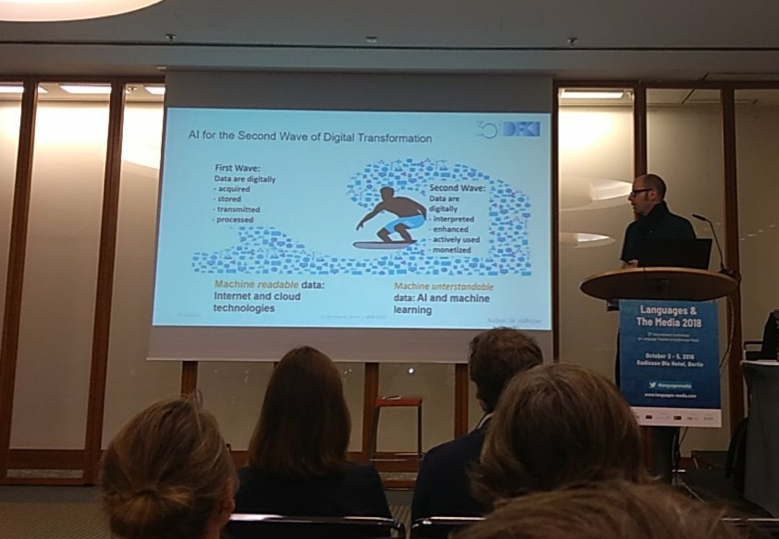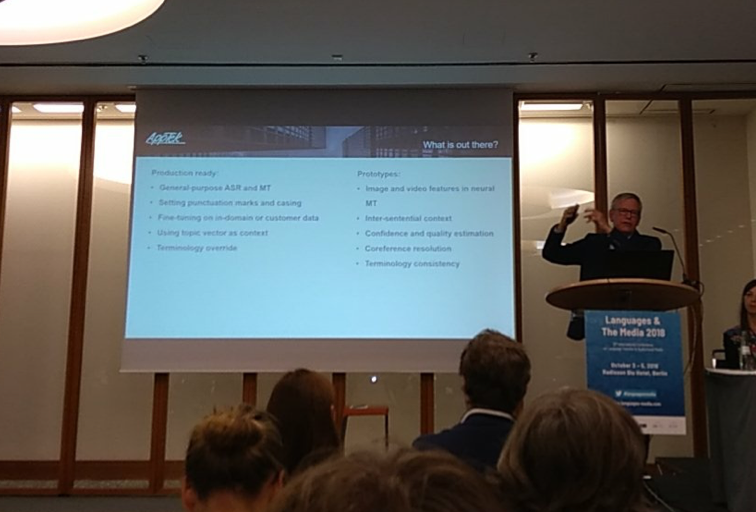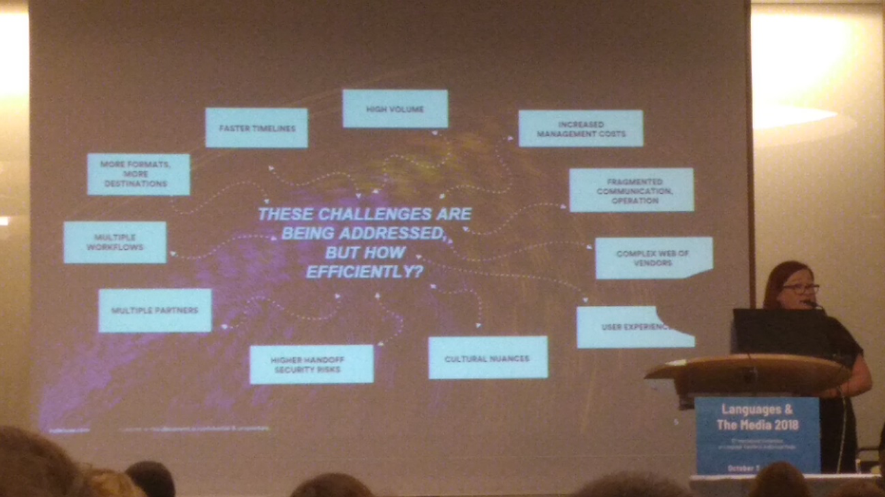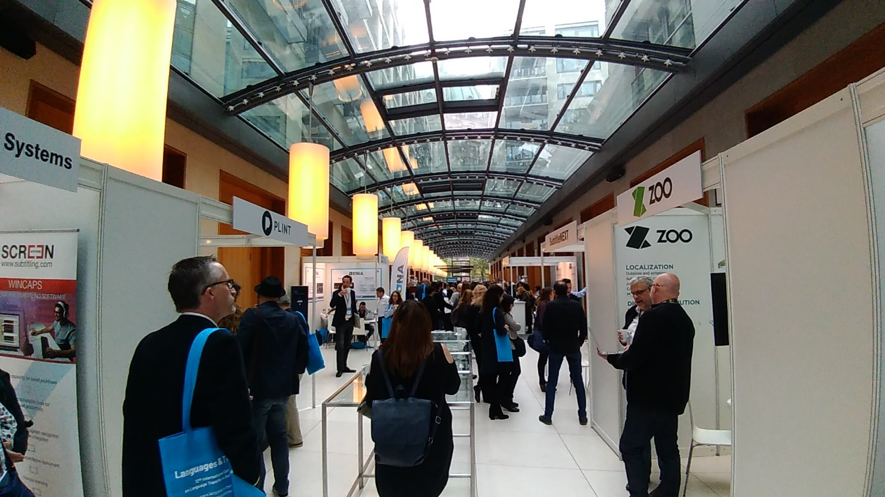by Mara Campbell
Not so many years ago, we were able to successfully manage life and work with only landlines, snail mail, and fax machines. But today, our world is dominated by a myriad of accessible and affordable technologies, and we can all agree there are benefits. Technology in everyday life helps us save time, be more efficient, have all the knowledge of the world’s collective brain literally in the palm of our hand. And it has also taken over our work life, particularly in our line of work.
In the last Languages & The Media conference, held on 3-5 October, 2018, in Berlin, Germany, technology was the connecting thread of most of the talks offered. Artificial Intelligence (AI), Machine Translation (MT) and Neural Machine Translation (NMT), Automatic Speech Recognition (ASR) are all now household names in the Audiovisual Translation field, and, fortunately, they are here to stay. Until recently, in our field, technology simply had the role of assisting human in tasks like timing subtitles, providing knowledge in the form of dictionaries, glossaries or consultation forums, giving us easy access to the assets we needed to work (videos, scripts, etc.). We provided the knowledge needed to operate such technology and the decision-making it required. But now, it could be argued that technology has the power to replace some of the know-how humans bring to the equation. In his talk, Dr. Aljoscha Burchardt, expert in language technology and artificial intelligence working at DFKI, explained this evolution: the first wave of digital transformation was data being digitally acquired, stored, transmitted, and processed, machine readable data supported by the internet and cloud technologies. The second wave of digital transformation in which we are currently immersed is data being digitally interpreted, enhanced, actively used, and monetized.
 Aljoscha Burchardt from DFKI explains the waves of digital transformation
Aljoscha Burchardt from DFKI explains the waves of digital transformation
This brings a new challenge to audiovisual translators: in the words of Volker Steinbiss, Managing Director at AppTek, “Embrace technology and use it to create more value”, because there is no point in starting a “battle” between humans and machines (spoiler alert: machines already won). Philip Klent from Südwestrundfunk adds, “how you combine [new technologies and human knowledge] makes the difference.”
 Volker Steinbiss from AppTek describes technology available
Volker Steinbiss from AppTek describes technology available
Companies are spending large amounts of money on developing new tools that will reach all areas of the audiovisual translation field. Sharyn Hopkins, SVP Worldwide Strategy & Business Development at Deluxe Entertainment Services Group, believes that “success requires a strategic transformation of technologies: technology is not only a part of [the] transformation, but is leading it.” Deluxe, one of the sponsor of the event, presented Deluxe One, “a cloud based platform that unifies the media supply chain.” Similarly, Nordisk Undertext had a booth where they introduced Plint, their “platform for cloud-based media localization and workflow management and orchestration.” Shana Priesz, VP of Worldwide Localization at Pixelogic Media, shared that her company has 60 in-house R&D professionals dedicated to developing tools to aid all steps of the AVT processes.
 Sharyn Hopkins from Deluxe shows the challenges her company is addressing
Sharyn Hopkins from Deluxe shows the challenges her company is addressing
Ron van Broeckhoven, Managing Director of VSI, proposes, “The subtitler of the future will have a supporting rather than a creative role. There is a need for more transparency: who adds value where. The modern subtitler knows how to add value where it matters.”
Dr. Serenella Massidda, Lecturer in Audiovisual Translation at Roehampton University, speaking about the future of localization in the cloud, ventured that “a strong partnership between media industry and academia is the key to improve future localization workflows and subtitling rates.” Shana Priesz says they “need universities to train more audiovisual translation professionals. Emerging markets have very few trained professionals.”
Our industry is currently very much Netflix-centered and -led, but let’s not forget that Netflix is a tech company, not an entertainment company and much less a localization company. Netflix (with such a huge spending budget) is constantly looking for ways to tweak workflows and improve processes. But there are and will be many other players in the field. Mazin Al-Jumaili, Director of Business Development, UK & Europe at ZOO Digital, predicts that the number of streaming video on demand (SVoD) platforms will increase to almost 700 in 138 countries by the year 2023. Dr. Massidda shared that Wired magazine stated that cable TV is definitively not dying. There has been an average yearly growth of 8% in the amount of US original scripted TV shows and movies for cable and SVoD since 2009. “The disruption of VoD platforms changed the localization game for good,” she affirms. So there are many doors we can knock on, and the differential we will be able to offer has to do with how we can adapt to technological changes and how we incorporate them into our own workflows.
Volker Denkel, Head of Digital Media and Access Services at ZDF Digital Medien-produktion, who is collaborating with the CompAsS (Computer Assisted Subtitling) project from the Tra&Co (Translation & Cognition) Center at the Johannes Gutenberg Unversität Mainz, shared CompAsS’ approach: “Rethink the workflows of subtitling and translation; Use of technology where it is helpful; Integration of technology already in use (ASR, post-editing, relay languages, MT.)” As translators, we should see this as an opportunity to reinvent ourselves, to try and “crack the system”, be aware of what the computer knows and can know, in order to figure out what it doesn’t, which will be what we ultimately can bring to the table. To shed light on this point, Denkel proposed these important questions: “At which specific points can computers assist and where are humans still better and will always be? What can the field of [Audiovisual Translation] adapt from other disciplines (e.g., digital platforms or project management tools). Who could help us to broaden our perspective?” A constant pursuit of answers to these questions is what will help us stay relevant in this field.


